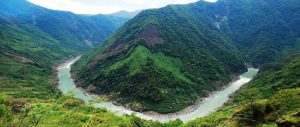China has confirmed it will resurrect a series of controversial hydropower dams in south-west China on rivers originating on the Tibetan Plateau, causing ripples of consternation from India and other downstream neighbours.
The 2011-15 energy sector blueprint, released by China’s State Council last week, confirmed plans to “actively push forward with hydropower development” in the Nu (Salween), Lancang (Mekong) and Yarlung Zangbo (Brahmaputra) river basins – all in ecologically sensitive and seismically active regions of Yunnan province and Tibet; and all along internationally shared rivers.
These plans mark a much anticipated step change in government policy, away from the more cautious approach to dam building in ecologically and seismically sensitive regions of the past decade.
Wen Jiabao’s tenure as Chinese premier saw a number of projects shelved. Only a third of schemes identified as a priority actually went ahead between 2006 and 2010. But the combination of China’s energy needs, intensive lobbying by major dam builders and electricity companies and ambitious plans to meet low-carbon intensity goals in the 12th Five-Year Plan have opened the way for a fresh round of dam building. Some 120 gigawatts of new hydropower will begin construction by 2015 nationwide, according to the plan.
Approval of three dam projects on the middle reaches of the Yarlung Zangbo River (known as the Brahmaputra once it reaches India), has triggered concerns in Indian media about possible impact on downstream flows. Construction of the 510-megawatt Zangmu dam, the river’s first large-scale hydropower station, is already under way.
Foreign ministry spokesman Hong Lei, quickly moved to clarify China’s stance on exploiting the Yarlung Zangbo at a press briefing on Wednesday: “The Chinese side always takes a responsible attitude towards the exploitation of cross-border rivers and every new project will be planned and reasoned in a scientific way (before being started),” he said, according to Xinhua.
Indian officials have also urged calm. But within government, there are advocates of urgent damming of the waters of the Brahmaputra in Assam and Arunachal Pradesh (where 168 mega-dams are slated), which in turn makes Bangladesh uneasy.
Notable is the lack of mention of the more contentious dam slated for the “great bend” in China, before the Yarlung Zangbo swings round into India and through the world’s deepest canyon. Here, a massive 48,000-megawatt dam (over twice the size of the Three Gorges dam) is under active consideration but is likely to be built only after related infrastructure and ultra-high voltage power transmission lines are complete.
The energy blueprint also mentions nine hydro projects on the Lancang (upper Mekong), which will have knock on effects for water flow, fisheries and agriculture for the 60 million people living in south-east Asia.
Within China, attention has focused on the revival of controversial plans to dam the Nu River in Yunnan province, eight years after these were suspended due to environmental concerns in one of the biggest triumphs to date of China’s green activists.
“This is really shocking,” said Li Bo, a director at Friends of Nature, a leading environmental group quoted in South China Morning Post. "There were signs during the past year that mega dams were staging a comeback after being put on hold for years, but I’m still shocked by the lack of transparency in the decision-making process behind this.
The State Council’s hydro plans should not come as a surprise (none of the project are new) – but the announcement will hasten a broader hydro-fuelled industrial development boom in southwest China and Tibet as local government uses new power sources to exploit the area’s rich mineral resources.
Dams on China’s fragile southeast region now seem a foregone conclusion, but thorny problems of ecology, geology and politics will not go away.
Within China, rows over the safety of large dam cascades in earthquake-prone south-west China have heated up in recent months following revelations that 48% lie in zones of high seismic hazard.
And news of these plans will do little for China’s diplomatic relations with downstream Asian countries. China has no formal agreements with its neighbours on the use of trans-boundary rivers and has shown little enthusiasm for engaging in the complex process of drawing these up, or offering up any good-will data.




